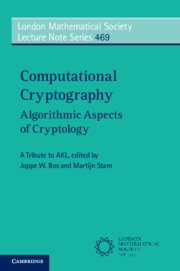Book contents
- Frontmatter
- Contents
- List of Contributors
- Preface
- 1 Introduction
- Part I Cryptanalysis
- 2 Lattice Attacks on NTRU and LWE: A History of Refinements
- 3 History of Integer Factorisation
- 4 Lattice-Based Integer Factorisation: An Introduction to Coppersmith’s Method
- 5 Computing Discrete Logarithms
- 6 RSA, DH and DSA in the Wild
- 7 A Survey of Chosen-Prefix Collision Attacks
- Part II Implementations
- References
- Index
7 - A Survey of Chosen-Prefix Collision Attacks
from Part I - Cryptanalysis
Published online by Cambridge University Press: 11 November 2021
- Frontmatter
- Contents
- List of Contributors
- Preface
- 1 Introduction
- Part I Cryptanalysis
- 2 Lattice Attacks on NTRU and LWE: A History of Refinements
- 3 History of Integer Factorisation
- 4 Lattice-Based Integer Factorisation: An Introduction to Coppersmith’s Method
- 5 Computing Discrete Logarithms
- 6 RSA, DH and DSA in the Wild
- 7 A Survey of Chosen-Prefix Collision Attacks
- Part II Implementations
- References
- Index
Summary
In Chapter 7, A Survey of Chosen-Prefix Collision Attacks, Marc Stevens surveys the technical advances, impact and usage of collision attacks for the most widely used cryptographic hash functions. Cryptographic hash function are the Swiss army knives within cryptography and are used in many applications including digital signature schemes, message authentication codes, password hashing, cryptocurrencies and content-addressable storage. Stevens was one of the driving forces in turning initial weaknesses in the compression function into practical attacks against various widely deployed protocols relying on hash function collision resistance for their security. In Chapter 7 he explains how each scenario involves the development of slightly different ideas to exploit weaknesses in especially MD5.
Keywords
Information
- Type
- Chapter
- Information
- Computational CryptographyAlgorithmic Aspects of Cryptology, pp. 182 - 220Publisher: Cambridge University PressPrint publication year: 2021
Accessibility standard: Unknown
Why this information is here
This section outlines the accessibility features of this content - including support for screen readers, full keyboard navigation and high-contrast display options. This may not be relevant for you.Accessibility Information
- 1
- Cited by
